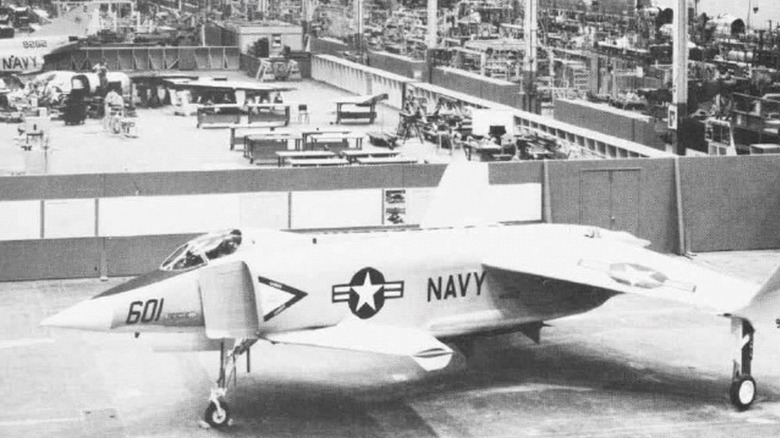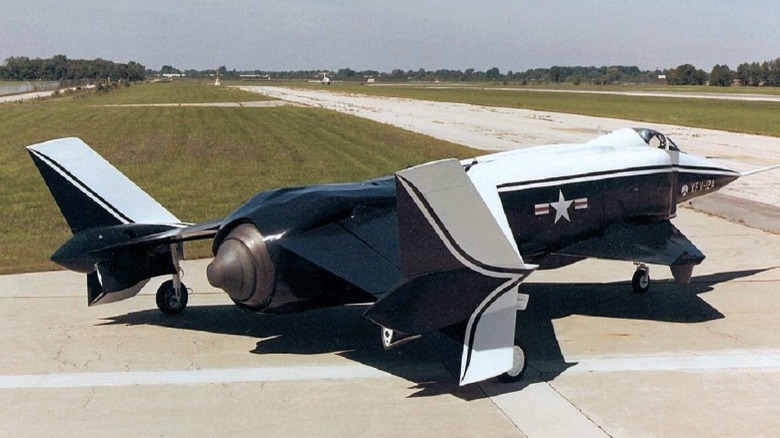Rockwell XFV-12: The Futuristic VTOL Fighter Jet That Couldn't Cut It
In the world of technology, it's not uncommon for an idea to seem entirely plausible on paper, only for the reality not to pan out. The key, in these sorts of scenarios, is to come to that realization before too much capital has been invested.
Very often, the military is at the forefront of such technological advancement, and the funding at its disposal can be staggering. In December 2022, President Joe Biden signed the Fiscal 2023 National Defense Authorization Act which reserved in $816.7 billion for the Defense Department. Over the decades, the United States has developed some of the most iconic military aircraft ever — the legendary B-52 among them — but also some others that were a little too experimental. Chief among them is the Rockwell XFV-12.
This intriguingly futuristic fighter jet was intended to be able to perform vertical takeoff and landing, but couldn't live up to the promise anticipated during development. Here's what went so wrong.
The development of the Rockwell XFV-12
The primary advantage of a VTOL aircraft is its versatility. From a military standpoint, the potential to be deployed with little constraint can't really be understated, and is an enormous boon for both defensive and offensive operations. In 1972, the U.S. Navy put out a request for proposal for a VTOL fighter/attack aircraft.
In response, Rockwell Collins International saw fit to get experimental. Very experimental. Elements from the A-4 Skyhawk and other existing jets were utilized in the prototype, resulting in familiar aspects like the cockpit being used in entirely new ways.
The concept, in short, was that the one-engine aircraft boasted "thrust-augmented wings." The aircraft directed its takeoff force at both wings from below, with the theory being that this would generate a very strong VTOL takeoff. It was certainly creative, but ultimately implausible ... at its time, at least. A few short years later, the pricey project was abandoned in 1981, never to make it beyond the prototype stage.
What went so wrong with the Rockwell XFV-12?
In October 2011, ASK the Academy spoke to Maciej Zborowski as part of the Young Professional Brief series. Zborowski, of Glenn Research Center, explained this failed design: "It used moveable flaps in the wings and canard, to direct engine exhaust [through] the flaps and thereby causing the surrounding air to be directed in a different direction," Zborowski said. "... they just didn't know of the ducting losses and airflow issues they would encounter."
Zborowski further noted that a model of the then-brand-new Lockheed Martin F-35 Lighting II achieved both VTOL and supersonic flight. "Imagine the fact that they were trying to do this in the '70s," he marveled. It might be cliched to state it, but true innovators dare to try, to hope, to experiment. The reason the Rockwell XFV-12 looks so futuristic and unlike the aircraft of its time is because that's exactly what it was.
It may have been a failure, but its promise was achieved by aircraft that followed. It has continued to inspire. In fact, In May 2012, per The Morning Journal, EHOVE Career Center students were given an opportunity to work with NASA Plum Wood, Ohio, to spruce up the remaining Rockwell XFV-12 cockpit, learning about the fascinating aircraft as they did so. The supersonic jets of the present and future owe it a debt.


